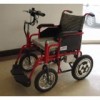6月7日,德国教育与科研部成立的肝功能系统研究小组发表公报说,他们用电脑模拟了肝脏的再生过程,且其结果在实验中得到证实。这一方法将有助于改善肝硬化等肝脏疾病的治疗。
肝脏是新陈代谢中最重要的器官之一,负责清除血液毒素等重要任务。肝脏还有令人惊讶的再生能力,即使受损超过50%还能几乎完全再生。学界至今对肝脏的再生能力所知甚少。
由德国和法国研究人员组成的研究小组利用电脑和系统生物学方法进行研究,引入各种参数并建立数学模型,成功模拟了化学中毒实验鼠肝脏的再生过程,并在后来的实体实验中证实了电脑预测结果的准确性。
研究人员说,能够模拟如此复杂的机制和准确预测器官改变的电脑模型非常罕见。这种方法有非常广泛的应用前景,例如可以用于模仿癌细胞在人体中的扩散等。(生物谷Bioon.com)
MCP:2型糖尿病发病过程中肝脏线粒体蛋白质组及其修饰的动态变化
Science :一种肝脏蛋白质可帮助分泌胰岛素
Hepatology:发现Cdc42在肝脏再生过程中调控的新机制
生物谷推荐原文出处:
PNAS doi: 10.1073/pnas.0909374107
Prediction and validation of cell alignment along microvessels as order principle to restore tissue architecture in liver regeneration
Stefan Hoehmea,1, Marc Brulportb,1, Alexander Bauerb, Essam Bedawyb, Wiebke Schormannb, Matthias Hermesb, Verena Puppeb, Rolf Gebhardtc, Sebastian Zellmerc, Michael Schwarzd, Ernesto Bockampe, Tobias Timmelf, Jan G. Hengstlerb,2, and Dirk Drasdoa,g,2
aInterdisciplinary Centre for Bioinformatics (IZBI), University of Leipzig, H?rtelstrasse 16-18, D-04107 Leipzig, Germany;
bLeibniz Research Centre for Working Environment and Human Factors (IfADo); University of Dortmund, Ardeystrasse 67, D-44139 Dortmund, Germany;
gInstitut National de Recherche en Informatique et en Automatique (INRIA), Unit Rocquencourt B.P. 105, 78153, Le Chesnay Cedex, France;
dInstitute of Experimental and Clinical Pharmacology and Toxicology, Department of Toxicology, University of Tübingen, Wilhelmstrasse 56, 72074 Tübingen, Germany;
cInstitute of Biochemistry, Medical Faculty, University of Leipzig, Johannisallee 30, 04103, Leipzig, Germany;
eClinical School of the Johannes Gutenberg–University Mainz Institute for Toxicology, Obere Zahlbacher Strasse 67, 55131 Mainz, Germany; and
fBiofluidmechanics Laboratory, Charite–Universit?tsmedizin Berlin, Berlin, Germany
Only little is known about how cells coordinately behave to establish functional tissue structure and restore microarchitecture during regeneration. Research in this field is hampered by a lack of techniques that allow quantification of tissue architecture and its development. To bridge this gap, we have established a procedure based on confocal laser scans, image processing, and three-dimensional tissue reconstruction, as well as quantitative mathematical modeling. As a proof of principle, we reconstructed and modeled liver regeneration in mice after damage by CCl4, a prototypical inducer of pericentral liver damage. We have chosen the regenerating liver as an example because of the tight link between liver architecture and function: the complex microarchitecture formed by hepatocytes and microvessels, i.e. sinusoids, ensures optimal exchange of metabolites between blood and hepatocytes. Our model captures all hepatocytes and sinusoids of a liver lobule during a 16 days regeneration process. The model unambiguously predicted a so-far unrecognized mechanism as essential for liver regeneration, whereby daughter hepatocytes align along the orientation of the closest sinusoid, a process which we named “hepatocyte-sinusoid alignment” (HSA). The simulated tissue architecture was only in agreement with the experimentally obtained data when HSA was included into the model and, moreover, no other likely mechanism could replace it. In order to experimentally validate the model of prediction of HSA, we analyzed the three-dimensional orientation of daughter hepatocytes in relation to the sinusoids. The results of this analysis clearly confirmed the model prediction. We believe our procedure is widely applicable in the systems biology of tissues.







